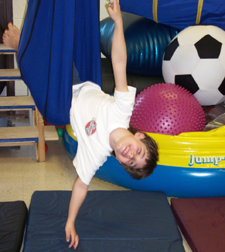
|
Pediatric Occupational, Physical, ABA/Behavioral, Feeding, Speech, and Language Therapies Main Clinic: 931-372-2567 1445 East 10th Street Cookeville, TN 38501 Email: [email protected] HIPAA Secure Email: [email protected] Fax: (931) 372-2572 ABA Clinic: 931-201-9534 400 Dubois Road Cookeville, TN 38501 Email: [email protected] Please call today to get started! Most insurances accepted! |

|
| Who needs therapy? | SE HABLA ESPAÑOL |
Why They Can't Sit Still

Children with sensory processing disorders have a tendency toward two major problems regarding sitting: Lack of focus and the inability to sit or stand for a long period of time. Their brain tends to "under register" movement, and without that ability, they can't focus. Their brains are telling their bodies to get up and move to help them listen and attend BETTER! They actually can't help getting up and squirming! Their brains are telling their bodies to do this to help them learn better! Although they look strong in quick actions, the body can't endure long periods of sitting or standing.
Successful strategies include allowing as much movement as possible without disrupting others while sitting.
When other organizing strategies are used, along with the new seating option, many children can double or triple previous sitting time periods.
These modifications include allowing small movement opportunities with the hands, using fidgets, or with the mouth, using gum or "chewys." Move and sit seat wedges or ball chairs are a life saver for many teachers! Using move and sit seat wedges, incline boards, and visual red timers can be explained by your OT!
The second major strategy is to provide as much support as possible while sitting so the body feels secure.
This includes: Feet flat on the floor or footrest, Good back support (No bucket-shaped plastic chairs!), and hips and knees at 90-degree angles.
Most classrooms have terrible seating arrangements and poor heights of student to tables!
Site empowered by
WebOnTheFly